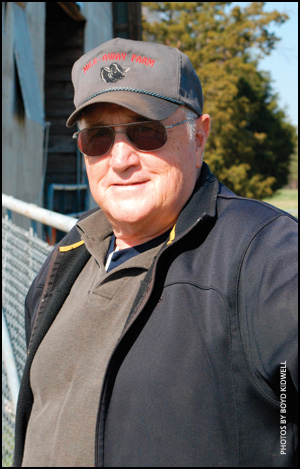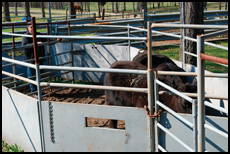MANAGEMENT...
Wizard with Steel
Like many cattle producers, John Brewer has held down a full-time job while running his farm. But a busy schedule hasn’t stopped the North Carolina cattleman from large-scale building projects on Mile Away Farm near the Virginia border. A heavy-duty handling  facility is a key part of this Angus breeder’s operation.
facility is a key part of this Angus breeder’s operation.
The beauty of Brewer’s building projects is they don’t require much in the way of out-of-pocket investments. For example, his cattle handling facility is built almost entirely with recycled materials that Brewer welded into a smooth-working layout.
“If you have a welder and surplus metal, you don’t need to buy much material to build pens and corrals,” says Brewer, who purchased only a headgate and palpation cage to build his handling system. Read more.

Check Bull Fertility Levels Before Breeding
Breeding season is right around the corner if not begun for spring-calving operations.
Proper bull management is crucial for a successful breeding season, says Jeremy Powell, assistant professor/Extension veterinarian with the University of Arkansas, Division of Agriculture. However, according to the 2008 U.S. Department of Agriculture (USDA) National Animal Health Monitoring System (NAHMS), only 27% of beef cattle operations annually test bulls before turning them out for the breeding season.
“Bulls can differ in their reproductive capabilities, and research studies show that one in five bulls that undergo a breeding soundness evaluation aren’t satisfactory breeders,” Powell says. “Obviously, results from using an infertile bull can be disappointing. … “You can’t afford to use a bull that isn’t a satisfactory potential breeder.” Read more.
Think Early
Why the grass may be greener on the other side of the early-weaning fence.
Although 205-day weaning is an industry standard, animal scientists say many ranchers choose weaning dates based on factors not related to their cattle and stick with them out of habit. Finding what’s really optimum means evaluating both economics and feasibility, individually. That process starts with having all the facts. Read more.
Pasture, Range in Good Condition
Pastures and ranges across the country continue to be in much better shape compared to a year ago and five-year average levels, according to the Chicago Mercantile Exchange’s (CME’s) June 16 Daily Livestock Report.
Citing the latest U.S. Department of Agriculture (USDA) weekly survey, the report notes 60% of pastures and ranges were rated in good or excellent conditions the week ending June 14 (compared to 51% a year ago and 50% for the five-year average). The survey ranked pasture and range conditions as the best since 2005.
These favorable conditions have “eased immediate pressure on cow-calf producers and slowed the pace of beef harvest, helping offset the increase in the number of dairy cows coming to market,” according to the Daily Livestock Report.
“However, the beef industry will have to contend long-term with a feed cost structure that is out of synch with beef prices paid in the domestic market.”
For the past two and a half years, producers have had to contend with drought in key areas as well as surging feed costs, which pushed a significant number of beef cows to market.
“The pace of liquidation has slowed this summer, but we are far from any herd rebuilding,” the report noted. “Overall, U.S. cow harvest is only 1.1% larger than last year but still 19.5% higher than the five-year average.”

Forage Production Efficiency Factors
The soils and sites available for forage production vary greatly, various species and classes of livestock are produced on different farms, and producers have widely differing resources and objectives. As a result, no two forage/livestock operations are exactly alike, and there is no one specific “correct” forage program. However, there are several key factors or concepts that have general application with regard to cost efficiency. These factors have always been important, but they loom as being even more important than ever in these days of high production inputs. Read more.

Kris Ringwall
Beef Talk
The curves are getting tight.
Tight curves on any roadway require a driver to slow down. Even if one is familiar with the road, changing conditions create unpredictability.
The same is true in the business of agriculture, especially the life of a farmer or rancher. Producer families spend much of their lives on the edge. When the edge is soft, it is better to pull back, rethink and see what happens. Read more.
Research with Summer Annuals
In dry climates, ranchers often run short on late summer and fall pasture. University of Idaho’s Nancy Cummings Research, Extension and Education Center in Salmon, Idaho, is looking at ways to extend grazing with use of summer annuals.
“We were looking at species that grow well in the dry corners of pivot-irrigated ground to increase hay yield or pasture,” John Hall, Extension beef specialist, says. “This evolved into a project to increase forage production for fall grazing or when renovating a hayfield. This year we’re taking off the first cutting on one alfalfa field we’re renovating, then no-till planting summer annuals to produce late-season grazing.”
When irrigation was available during the 60-day growing season last year, they got between two and three tons per acre with some species. Some plots were given only a month of irrigation, with the water turned off Aug. 1, to simulate what happens on many ranches in this part of the country when water is no longer available.
Test plots contained five species of warm-season annuals, including Sudex, teff, German foxtail millet, pearl millet and grazing corn planted July 1. Production varied from 0.5 tons per acre for pearl millet with no irrigation after early August to 5.6 tons per acre for Sudex (sorghum-Sudan grasses) with full-season irrigation. The most promising species, according to Hall, were Sudex, German foxtail millet and teff, since all of them produced more than 2.5 tons per acre in less than 60 days.
Tips for Managing Cattle Feeding During Tough Times
Once again cattle feeders are in an extended period of economic challenges and need to take advantage of every opportunity to survive in these tough economic times, a University of Nebraska-Lincoln (UNL) beef cattle specialist said.
“The problems cattle feeders face today are not much different from other years,” said Terry Mader, UNL beef cattle specialist at the Haskell Agricultural Laboratory near Concord. “However, today’s economic conditions magnify the problems faced, and fluctuating feed costs and volatile markets force a greater sense of urgency.”
To head off economic downturn at the feedlot, Mader offers feedlot management tips. Read more.

Ron Torell
Back to Basics
Ladybug salad
My wife and I recently took my 80-year-old mother out to lunch. It wasn’t a fancy establishment, simply a family-style restaurant that serves good home-style cooking and the kind she grew up on. We all ordered our meals with salads on the side.
Not long into the meal my mom asked, “What is that crawling out of my salad?” I quickly identified the uninvited guest as a ladybug minus one wing. The good wing was drenched in salad dressing. Laughing, while not fazed a bit, my mom, with her fork, moved the bug off her plate and continued to eat her salad.
Wishing all patrons were as understanding as my mom, the manager explained that even though we did not order organic salads, the lettuce used was what they purchased for their organic orders. Read more.
Advances in Use of Sexed Semen
Some producers are utilizing sexed semen to create replacement heifers from their best cows or to skew the calf crop toward a higher percentage of steers for market. The University of Idaho bred more than 30 cows using the technology. This year, working with ABS Global, they bred 100 cows with X-sorted semen, using fixed-time artificial insemination (AI) and synchronization. Read more.




